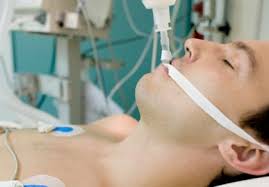Three variables included in GCS were best motor response, best verbal response, and eye opening. Best motor response is a reflection of the level of CNS function, best verbal response shows the CNS’s ability to integrate information, and eye opening is a function of brainstem activity.
Scores range from 3 to 15, with a higher number representing an increased degree of patient's consciousness. The use of the letter T designates that the patient was intubated at the time of the examination.
From a prospective multicenter study, patients who had an admission GCS of 9 or less correlated with higher mortality rates, regardless of center volume, mechanism of injury, or treatment. Therefore, this system can be used to predict outcomes. The GCS has weaknesses in that it does not take into account focal or lateralizing signs, diffuse metabolic processes, or intoxication.
Glasgow Coma Scale:
Eye opening:
Spontaneously = 4
To speech = 3
To pain = 2
None = 1
Motor response:
Obeys = 6
Localizes pain = 5
Withdraws from pain = 4
Flexion to pain = 3
Extension to pain = 2
None = 1
Verbal response:
Oriented = 5
Confused = 4
Inappropriate = 3
Incomprehensible = 2
None = 1
Patient's score determines category of neurologic impairment:
15 = normal
13-14 = mild injury
9-12 = moderate injury
3-8 = severe injury
Source: Miloro, M.; et.al. 2004. Peterson's Principles of Oral and Maxillofacial Surgery. Ontario: BC Decker Inc.
Scores range from 3 to 15, with a higher number representing an increased degree of patient's consciousness. The use of the letter T designates that the patient was intubated at the time of the examination.
From a prospective multicenter study, patients who had an admission GCS of 9 or less correlated with higher mortality rates, regardless of center volume, mechanism of injury, or treatment. Therefore, this system can be used to predict outcomes. The GCS has weaknesses in that it does not take into account focal or lateralizing signs, diffuse metabolic processes, or intoxication.
Glasgow Coma Scale:
Eye opening:
Spontaneously = 4
To speech = 3
To pain = 2
None = 1
Motor response:
Obeys = 6
Localizes pain = 5
Withdraws from pain = 4
Flexion to pain = 3
Extension to pain = 2
None = 1
Verbal response:
Oriented = 5
Confused = 4
Inappropriate = 3
Incomprehensible = 2
None = 1
Patient's score determines category of neurologic impairment:
15 = normal
13-14 = mild injury
9-12 = moderate injury
3-8 = severe injury
Source: Miloro, M.; et.al. 2004. Peterson's Principles of Oral and Maxillofacial Surgery. Ontario: BC Decker Inc.





 Glasgow Coma Scale (GCS)
Glasgow Coma Scale (GCS)

thank, for your visit to my blog,
sangat komplit ni keterangannya